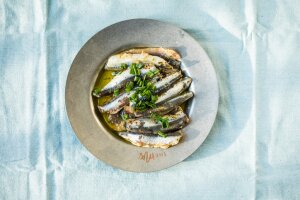How to Give Your Mediterranean Diet a Spanish Flair

Spain is among the 22 countries surrounding the Mediterranean Sea, yet Spanish cuisine is often overlooked when discussing the Mediterranean diet. Additionally, Spain is one of the healthiest countries in the world according to the Bloomberg Global Health Index. The Mediterranean diet, which is rich in seafood, healthy fats, legumes, fruits and vegetables, is a key pillar of Spain’s food culture.
(Getty Images)
A recent study from Spain showed health benefits of eating a Spanish version of the Mediterranean diet. PREDIMED, a randomized controlled trial funded by the Spanish Ministry of Health, is one of the largest Mediterranean diet studies in recent years. Results of the study show that the incidence of major cardiovascular events was 30% lower among Spaniards following a Mediterranean diet rich in extra-virgin olive oil and nuts compared to a reduced-fat diet.
Additional analyses of the PREDIMED study of Spanish citizens found that the Mediterranean diet was linked to a reduced incidence of metabolic syndrome, Type 2 diabetes and breast cancer.
Basque Country Cuisine
People in Spain have eaten Mediterranean diet foods for centuries. I witnessed this Spanish Mediterranean diet firsthand during my recent visit to the Basque Country, which is located on the Spanish-French border in northern Spain.
Basque food reflects the culture and heritage of the region, which is shaped by its unique combination of the sea, rolling green pastures and jagged mountains. The cuisine relies on locally sourced ingredients and freshly caught seafood with traditional, time-honored recipes that have been passed down generationally.
Basque Country has also emerged as one of the most highly acclaimed destinations in the world for exquisite cuisine, with more Michelin-starred restaurants per capita than in other region in the world. Still, most home cooks in the Basque Country do not rely on exotic ingredients or flashy techniques. Instead, they value high-quality locally-grown foods simply prepared.
Here are some of the foods I enjoyed during my visit to the Basque Country – specifically Bilbao and San Sabastian – and how you can infuse some Spanish flavor and cultural foods into your own Mediterranean-style diet.
Spanish Olive Oil
A staple of the Mediterranean diet, olive oil is often most associated with Italy’s olive groves. Yet Spain is the world’s top producer of olive oil, and it plays an equally dominant role in the cuisine. More than 200 varieties of olives are grown in Spain, each with its own flavor and aroma.
In the Basque country, olive oil is a featured ingredient in multiple memorable dishes, including a perfectly ripe sliced tomato with a few slivers of onion, fresh parsley and a generous drizzle of olive oil. It was also a dominant flavor in a delicious garlic soup, or sopa de ajo, which is made with loads of garlic sautéed in olive oil and then combined with broth, along with bread and whisked eggs to thicken the soup.
Olive oil was also used to fry a not-too-sweet dessert called torrijas, which is like a Spanish-style French toast or bread pudding. I enjoyed this dessert at the Michelin-starred Casa Urola in San Sebastian. It’s a good reminder that olive oil can replace butter when making some desserts, especially olive oil cakes.
Fresh Spanish Seafood
Due to its geographical position in the Bay of Biscay, the Basques have been seafarers for centuries. In fact, “most of the sailors on Columbus’ ships were Basques,” says award-winning food writer Elisabeth Luard, author of “The Food of Spain and Portugal: A Regional Celebration.”
Popular fish dishes in Basque include oven-baked spider crab, cuttlefish or squid in its own ink, baby eels with fiery chili peppers and tuna or bonito in one-pot stews, she says.
I enjoyed many classic fish dishes while in the Basque Country. The first I made myself at a cooking school in the La Vivera Market in Bilbao: cod in pil-pil sauce or bacalao al pil-pil. The creamy sauce is made from an emulsion of fish broth, olive oil and garlic, a common technique for making fish at home. Search online and you can easily find recipes for cod in pil-pil sauce.
Another iconic Basque fish dish is called kokotxas, which is made with hake fish cheeks. This fish stew is often served with salsa verde, a mixture of olive oil, garlic, white wine and fresh parsley, which is the most popular fresh herb used in Basque cooking.
While fresh fish markets were abundant in the Basque Country, don’t let the scarcity or intimidation be a reason for avoiding cooking fish or seafood at home. Fresh fish can be simply prepared by grilling, sauteeing or baking. Or look for the growing array of pre-portioned and seasoned fish in the freezer aisle. Aim for at least two servings of fish per week and explore some of the Basque-style preparations.
Tinned or Canned Fish
Some of the best fish in the Basque Country actually comes in a can. The region is known for its handcrafted canned tuna and anchovies, which are beloved delicacies in the Basque Country. This premium tuna is far different from what you may buy to make mayonnaise-laden tuna fish sandwiches at home.
I toured the Arroyabe artisan fish cannery in Bermeo to observe the entire process, from the traditional pole and line fishing of the tuna to the one-by-one packing in cans or glass jars by meticulous workers. The white albacore tuna or bonito del norte is packed in olive oil that infuses the flavor of the fish and adds even more healthy fats to the tuna.
The Basque Cantabrian anchovies are among the most appreciated and renowned anchovies worldwide for their meatiness, smooth texture and intense flavor. If you don’t think you like anchovies based on past experiences as a pizza topping, these are worthy of another try.
Shelf-stable tinned fish has long been enjoyed in the Basque Country, but it’s seen a resurgence in the U.S. thanks to TikTok, where #tinnedfish videos have garnered 62 million views. Tinned fish date nights and seacuturie boards have helped introduce a whole new generation to anchovies, sardines, tuna belly, mussels and other canned fish.
Tinned fish meal ideas
Look for tinned fish in specialty food stores and online, and enjoy them in a variety of ways:
- Add tinned fish to salads and top with lemon or lemon vinaigrette.
- Elevate pasta dishes with anchovies, mussels or another canned fish.
- Try glida, a toothpick-skewered olive, anchovy and picked guindilla or piparras pepper. This is a type of pinxos, or Basque-style tapas.
Vegetables of the Basque Country
Vegetables play a dominant role in Basque cuisine, especially tomatoes, peppers, onions, leeks, eggplant, potatoes, mushrooms, artichokes and asparagus. White asparagus was in season during my visit, and I enjoyed grilled white asparagus exquisitely prepared in San Sabastian.
Colorful produce markets were a beautiful sight throughout the Basque Country, with seasonal vegetables creatively displayed in baskets and bins. At produce markets, you can find local products that are only found in the region, such as Espelette peppers. This bright red chili pepper is so integral to Basque cuisine that it has its own festival each year.
Mediterranean mushrooms
“The Basques take their wild foods – particularly mushrooms – very seriously,” says Luard. “Around 30 separate edible species of fungi are gathered in the season, many of them avoided elsewhere,” she says.
Wild mushroom picking is a deeply rooted practice in the Basque Country, and these fungi are grilled with olive oil, sauteed with eggs for reveulto, added to toasts or skewered for pintxos.
Fresh mushrooms are a sustainable nutrient powerhouse that are available year-round in U.S. supermarkets. Try different varieties and explore new recipes to incorporate more mushrooms, including in salads, bowls, grain dishes, stir-fries and as a meat alternative.
Basque Legumes
Legumes are a staple of the Mediterranean diet, and they’re a starring ingredient in Basque cuisine, especially in soups, stews and bean-based pintxos. The most famous of the Basque beans is the Tolosa black beans, named for the small picturesque village Tolosa near San Sabastian.
Tolosa celebrates a four-day bean festival to honor the “little black pearl” and sample different bean dishes. Grown in traditional ways on small family farms, Tolosa black beans are protected by a “designation of origin” label similar to many local specialties in the Basque Country.
The Basques are enamored with beans, and other towns are known specifically for the beans that are grown there. While you may not easily find Basque beans (although some varieties are sold online), do not ignore the value of these versatile, nutrient-dense ingredients.
Beans are a tremendous source of plant-based protein, fiber and a variety of vitamins and minerals, yet sometimes their contributions to the Mediterranean diet are overlooked. Dishes are typically made with dried beans in the Basque Country, but don’t hesitate to use canned beans instead. They’re just as nutritious (although be sure to rinse before using).
Try adding black beans, cannellini, pinto beans, red beans, chickpeas and other legumes to salads, pasta dishes and soups. Or use beans for making dips, veggie burgers and baked goods.
Local Wine in Basque Country
Moderate wine consumption is part of the Mediterranean diet, and red wine is typically what people think of first. Yet, white wine is absolutely included in the Mediterranean diet and offers similar benefits in moderate amounts.
In Basque Country, a popular wine isTxakoli (pronounced “cha-ko-lee”). This is a mildly sparkling, dry white wine that is predominantly made with local grapes known as Hondarrabi Zuri, a variety that thrives in the mountainous terrain and seaside setting. I really wasn’t familiar with this wine before (also known as Txakolina), but now I’ll be seeking it out in wine shops and Mediterranean-style restaurants back home.
Three main regions in the Basque Country produce Txakoli: Geratia, Bizkaia and Araba. The wines have their own characteristics based on the area. For example, vineyards closer to the sea have a greater minerality and salinity. Wines from all three areas carry the country’s “designation of origin” seal, which makes them bound by specific production rules. Txokoli wine has been produced in the Basque Country since the 9th century.
Besides the bright, crisp taste of Txakoli – which pairs incredibly well with seafood – the Basque wine is lower in alcohol compared to other wines. It’s considered a low-alcohol by volume wine, hovering between 8 and 11%. Low-ABV wines are increasingly in demand as mindful drinkers want to manage alcohol consumption.
Once rarely known outside of the Basque Country, Txakoli wines are now finding their way on restaurant wine lists and are sold at specialty retailers in the U.S. To learn more about Txakoli wines, I visited two Basque wineries: Hiruzta and Mokoroa.
Wine is included in the Mediterranean diet pyramid, yet it is recommended to be consumed with food and only in moderation: two glasses a day for men and one glass for women.
Social Meals
A big part of the Mediterranean way of life is to slow down and enjoy your food – especially with family and friends. This is another appealing aspect of Basque food culture.
Basque gastronomic societies, or txokos, are centuries-old clubs that revolve around cooking and enjoying food together as a group. Started as men-only cooking clubs, they provided a forum for teaching the old ways and encouraging gastronomic innovation, says Luard.
“A Basque of my long-time acquaintance explains their existence as a response to not being allowed in the kitchen by their women,” Luard says. She explains that “More likely the roots lie in the habit, common to many sea-going nations, of sailors who cooked their own special dishes on shipboard – a theory borne out by the annual competitions the societies organize to find the best marmitako, a fisherman’s stew of ancient provenance.”
Whatever the origins, the cooking clubs are places for members to gather, socialize, and connect through the preparation and enjoyment of good food and drinks. This is the perfect illustration of how the joy of cooking and eating – along with the appreciation of culinary heritage – are central to Basque culture.
While the cuisines of Italy and Greece may be most frequently mentioned when referring to the Mediterranean diet, do not overlook the traditional foods and eating styles of Spain, especially in the Basque Country.




